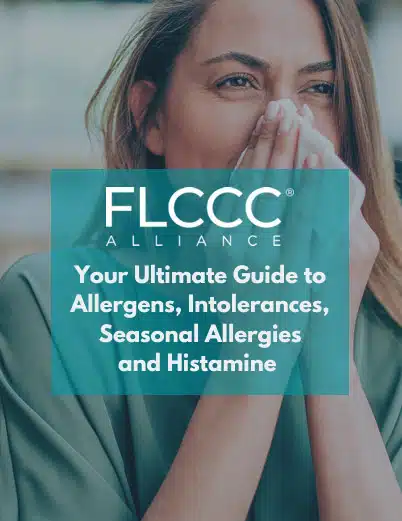Everything you need to know about allergens, intolerances, seasonal allergies & histamine is right here in FLCCC’s Allergy Guide!

If you’ve ever dealt with allergies, or even if you know somebody who has, then you know how frustrating they can be. FLCCC’s Allergy Guide is here to help! Written and compiled by the fabulous duo of Kristina’s (Dr. Kristina Carman and Kristina Morros, CRNA), this guide has everything you need to better manage allergies in their many forms.
Get the complete guide right here:
About this Guide
This guide aims to help people identify and treat common allergies and intolerances. There are many ways to improve the body’s response to triggers that cause inflammation. It starts with finding the problem and making dietary and lifestyle changes to restore balance.
If these steps don’t solve the issue, there are other therapies and treatments to try before resorting to conventional remedies. Authors Dr. Kristina Carman and Kristina Morros, CRNA have provided a step-by step approach to managing allergens and intolerances in this guide.
The text below serves as a brief summary of the information contained in the guide. The guide itself contains more than 40 pages of info, so don’t skip it!
For more information on supplements, low histamine diets, and lifestyle tips, visit the FLCCC Tools and Guides section on the FLCCC website. There you’ll find resources like this:
- 20+ Daily Things to Improve Your Health
- What is a Low-Histamine Diet?
- From A to Zinc: FLCCC Nutrient Guide
All About Food Allergens & Intolerance
Adverse food reactions occur when the body exhibits an abnormal response following food consumption. The three primary types of adverse food reactions are food allergy, food sensitivity, and food intolerance.
In the allergy guide, we touch on the following:
- Food Allergy
- Food Sensitivity
- Food Intolerance
- Common Food Allergens
- Food Allergen Labeling
Food Allergy
Food allergies effect around 1-2% of adults and fewer than 10% of children, with varying prevalence.
- Type 1 hypersensitivity reaction
- Anaphylaxis
Food Sensitivity
Food sensitivities and food-chemical sensitivities represent complex non-allergic and non-celiac inflammatory responses that can activate both innate and adaptive immune pathways.
- Non-Type 1 hypersensitivity response
- “Any other immune-mediated (non-Type 1 hypersensitivity) reaction”
- Does not pose a life-threatening risk
- Non-Immune mediated reactions (doesn’t involve chemical mediator release)
Food Intolerance
Food intolerances are estimated to affect approximately 20% of the population. The diagnosis and management of food intolerances pose a complex challenge due to their varied presentations and involvement of non-immunological mechanisms.
- Examples: Lactose intolerance, bile salt deficiency, etc.
- Different underlying causes between food allergy and food intolerance lead to specific ways to diagnose and treat them, based on their immune system involvement.
Common Food Allergens
Over 170 foods are identified as triggers for food allergies. Yet, eight specific foods are responsible for 90% of allergic reactions in the American population:
- Milk
- Eggs
- Peanuts
- Tree Nuts
- Fish
- Shellfish
- Soy Products
- Wheat
- Gluten
👉 Learn More: Eat Your Way To Allergy Relief
Food Allergen Labeling
Food labels in the United States must clearly disclose major food allergens by law. When looking into food labels, you want to check for:
- Ingredients
- “Contains” statement
Ingredients known to be major allergens must either include the allergen’s food source within the ingredient’s common name, like “lecithin (soy),” “flour (wheat),” and “whey (milk),” or through a “contains” statement following the ingredient list, such as “Contains Wheat, Milk, and Soy.”
However, these labeling requirements by the Food Allergen Labeling and Consumer Protection Act (FALCPA) do not cover accidental allergen exposure from cross-contact during manufacturing. The FDA advises that allergen advisory statements like “may contain [allergen]” are not substitutes for proper manufacturing practices and must be truthful to avoid misleading consumers.

Allergic Reactions Explained
There are a number of different allergic reactions that people experience. They can all be divided amongst two categories:
- IgE-Mediated Reactions: Typical Allergies
- IgG Reactions: Food Sensitivities
IgE-Mediated Reactions: Typical Allergies
IgE antibodies develop in response to allergens such as pollen, pet dander, or certain foods. This reaction is usually immediate, occurring within minutes of exposure to the allergen.
Common allergy symptoms include
- Hives
- Itching
- Swelling
- Redness
- Respiratory problems (such as asthma)
- Gastrointestinal discomfort.
Severe reactions can lead to anaphylaxis, a critical health risk requiring immediate medical attention and may include difficulty breathing, a sharp drop in blood pressure, dizziness, and loss of consciousness.
Examples: Seasonal allergies (e.g., hay fever), Specific food allergies (e.g., peanuts or shellfish), Reactions to insect stings
IgG Reactions: Food Sensitivities
IgG antibodies, the most prevalent type, can bind to various pathogens for longer durations, often related to food sensitivities. IgG-mediated reactions can be delayed, sometimes appearing hours or days later.
Common symptoms include
- Headaches
- Digestive discomfort (such as bloating or gas)
- Joint pain
- Fatigue
- Skin problems like eczema
These reactions are usually not life-threatening but can cause ongoing discomfort and chronic health problems.
Examples: Sensitivities to certain foods like dairy, gluten, or specific additives.
Key Differences between IgE and IgG Reactions
- Speed of Reaction: IgE reactions are immediate and severe, while IgG reactions are delayed and typically less severe.
- Type of Symptoms: IgE reactions lead to acute allergic symptoms, while IgG reactions result in chronic, less specific symptoms.
- Life-Threatening Potential: IgE reactions can be life-threatening, whereas IgG reactions are generally not.
- Diagnostic Testing: IgE allergies can be identified through skin prick tests and specific IgE blood tests, while IgG sensitivities are often diagnosed through elimination diets and specific IgG blood tests.
- Treatment and Management: IgE-mediated allergies may require trigger avoidance, emergency medications like epinephrine, and potentially immunotherapy. Managing IgG sensitivities often involves dietary adjustments and addressing underlying health concerns.
Seasonal Allergies Explained
Seasonal allergies, unlike colds, are not triggered by a virus despite sharing similar symptoms. Seasonal allergies can be a persistent condition that greatly affects the quality of life during specific seasons.
The intensity of allergies can differ significantly among individuals and may fluctuate over time, sometimes even from one year to the next. People have varying allergic reactions to different pollen types, leading to differences in symptom timing and severity.

Is It Seasonal Allergies or Food Sensitivity?
Airborne allergies and food groups airborne allergies, like pollen and dust, can interact with specific foods, leading to oral allergy syndrome (OAS) or pollen-food syndrome. This reaction occurs when an individual allergic to a particular type of pollen has a similar response to related foods due to shared proteins.
- Birch Pollen Allergy: Often linked to reactions to apples, pears, peaches, plums, almonds, carrots, celery, parsley, and various fruits and vegetables.
- Grass Pollen Allergy: Associated with reactions to melons, tomatoes, oranges, and peaches.
- Ragweed Pollen Allergy: Could trigger reactions to bananas, melons, zucchini, cucumber, and sunflower seeds.
- Mugwort Pollen Allergy: Related to reactions to celery, apples, kiwi, peanuts, and carrots. allergens
- Latex-Fruit Syndrome: Individuals allergic to latex may also react to foods like bananas, avocados, kiwi, chestnut, and papaya.
- Animal Allergens: Those allergic to animal dander might have reactions to specific meats.
Symptoms of OAS typically include mouth, face, lip, tongue, and throat itching or swelling immediately after consuming raw fruits or vegetables. Cooking these foods often prevents the reaction, as heating alters the protein structure, reducing allergenicity.
Histamines Explained
You may have heard the word histamine thrown around, but how much do you know about it?
What is Histamine?
Histamine, a compound found in almost all body tissues, plays a key role in local immune responses, gut function, and as a brain neurotransmitter. Produced by basophils and mast cells, it’s crucial in allergic reactions, contributing to symptoms of both seasonal allergies like hay fever and food-related allergies.
Further topics explored in the PDF:
- Histamine’s Role in Allergic Reactions
- Histamine in Seasonal Allergies
- Histamine in Food Allergies
- Histamine-Related Gastrointestinal Disorders
- Histamine-Related Neurological Conditions
- A lot more: Download the Guide!
Further reading on histamines:
- Resource: Low Histamine Foods List
- Guide: Histamines and Gut Health
- Webinar: COVID, Histamines, and the Gut
What is Mast Cell Activation
Mast Cell Activation involves mast cells—white blood cells in all body tissues—releasing histamine and other inflammatory substances. Triggered by allergens, injury, stress, chemicals, or infections, this process is essential for immune defense. However, excessive activation can cause issues like allergic reactions, asthma, and Mast Cell Activation Syndrome (MCAS).
Further topics explored in the PDF:
- Histamine in Seasonal Allergies
- Histamine in Food Allergies
- Mast Cell Activation Syndrome (MCAS)
- Diagnosis and Management
- Mast Cell Activation in Allergies
- The Role of Estrogen on Mast Cell Activation
Diet, Lifestyle and Complementary Treatment for Allergies
If you’ve been suffering from allergy symptoms, you should know that there is really a lot you can do to feel better! Take a look at the following allergy treatments. And don’t forget, you’ll find a lot more in the PDF version of this guide.

- Natural Remedies and Supplements: Quercetin, Bromelain, Vitamin C, Omega-3 Fatty Acids, Vitamin D, Many more.
- Herbs and Adaptogens: Turmeric (Curcumin), Ginger, Licorice Root, Ashwagandha, Holy Basil (Tulsi),
- Medicinal Mushrooms: Reishi, Cordyceps, Shiitake, Chaga
- Diet: Anti-inflammatory diet, Low-histamine diet, Avoid trigger foods
- Lifestyle Changes: Drink lots of water, Use saline solution to clean nasal passage, Yoga, Meditation, Sleep
- Complimentary Treatments: Kinesiology, NAET Therapy (Nambudripad’s Allergy Elimination Techniques), Acupuncture
FLCCC Wants You To Be Allergen Free!
Allergies affect millions of people worldwide. Many of those impacted may not even know what is making them feel sick. We hope this guide can help people begin to home in on their symptoms and discover their root cause.
As you can see, there’s a lot more to food allergies than “gluten-free”, and there’s a lot more to seasonal allergies than “itchy eyes”. Allergies are complex and evaluating their impact on patients requires a skillful practitioner. If you’re looking for one of those, head to our provider database, or join FLCCC’s Forums to join our community of health-minded folks just like yourself!



